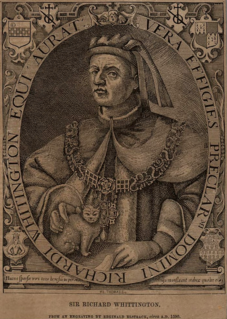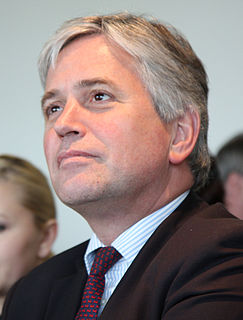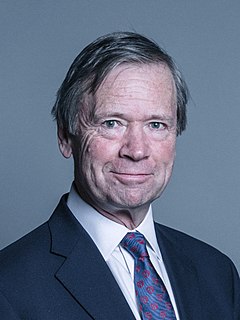Related Research Articles

Richard Whittington of the parish of St Michael Paternoster Royal, City of London, was an English merchant and a politician of the late medieval period. He is also the real-life inspiration for the English folk tale Dick Whittington and His Cat. He was four times Lord Mayor of London, a member of parliament and a Sheriff of London. In his lifetime he financed a number of public projects, such as drainage systems in poor areas of medieval London, and a hospital ward for unmarried mothers. He bequeathed his fortune to form the Charity of Sir Richard Whittington which, nearly 600 years later, continues to assist people in need.

Sir William Walworth was an English nobleman and politician who was twice Lord Mayor of London. He is best known for killing Wat Tyler.
Sir Nicholas Brembre was a wealthy magnate and a chief ally of King Richard II in 14th-century England. He was Lord Mayor of London in 1377, and again from 1383–5. Named a "worthie and puissant man of the city" by Richard Grafton, he became a citizen and grocer of London, and in 1372-3 purchased from the Malmains family the estates of Mereworth, Maplescomb, and West Peckham, in Kent. His ties to Richard ultimately resulted in his downfall, as the anti-Richard Lords Appellant effectively took control of the government and imprisoned, exiled, or executed most of Richard's court. Despite Richard's efforts, Brembre was executed in 1388 for treason at the behest of the Lords Appellant.

Nicholas John Anstee is the former Lord Mayor of the City of London; he was the 682nd person to serve as mayor and his term was from 2009 to 2010. He serves as Alderman for the Ward of Aldersgate having previously been its representative in the City since his election as a Common Councilman in 1987.

Sir Martin Bowes was a very prominent and active civic dignitary of Tudor London whose career continued through the reigns of Henry VIII, Edward VI, Mary I and Elizabeth I. Born into the citizenry of York, Bowes was apprenticed in London and made his career at the Royal Mint, as a master-worker and under-treasurer, and personally implemented the debasement of English currency which became a fiscal imperative in the later reign of Henry.

Jeffrey Richard de Corban Evans, 4th Baron Mountevans, is a London shipbroker and British hereditary peer, who served as Lord Mayor of London from 2015 to 2016.
Sir John Gore was an English merchant who was Lord Mayor of London in 1624.
Sir John Wollaston was an English merchant who was Lord Mayor of London in 1643.
William Standon, of Wimpole, Cambridgeshire and London, was Sheriff and Mayor of London and a Member of Parliament.
William Sevenoke was a grocer and politician who served as Mayor of London in 1418, and as warden of London Bridge, alderman of Bishopsgate Ward, alderman of Tower Ward, Warden of the Grocers' Company, Sheriff of London, Member of Parliament for the City of London and Surveyor of the King's works at Isleworth.
Henry le Walleis was a 13th-century English politician and Mayor of London. His origins are obscure; he was an outsider to London and may have been Welsh by birth. After making his fortune in the wine trade, he became an alderman in 1269 and sheriff in 1270. As alderman, he represented the ward of Cordwainer. He went on to serve five terms as mayor.
Sir Robert Chichele was a 15th-century English merchant and Lord Mayor of London.
Nicholas de Farndone was a 14th-century English goldsmith and politician who served four non-consecutive terms as Mayor of London.
Sir Cuthbert Buckell was a 16th-century English merchant and Lord Mayor of London. He was born in Westmorland, the son of Christopher Buckle. He was a member of the Vintners Company of London. He later pursued political offices, and was elected alderman of Farrington ward in 1582. That same year, he served a partial term as one of the Sheriffs of London, to finish the term of John Haydon, who had died in office. He was elected mayor in 1593. One notable event of his term was the Dutch Church Libel, in which bills were posted in London against French Protestant refugees; Buckell received a letter from the Privy Council urging him to find and interrogate those responsible. Buckell's term was also marked by a virulent epidemic of plague, as a result of which he ordered all of the theatres of London closed. He died before completing his term of office. His term was completed by Richard Martin. He was a generous benefactor to Brough-under-Stainmore, both in life and in his will. He was buried at St Mary-at-Hill in London. Among his descendants was Sarah Crowe, wife of John Carpenter, 4th Earl of Tyrconnell.
Andrew Aubrey was an English merchant and politician, who served three terms as Lord Mayor of London during the reign of Edward III.
Sir Stuart Knill, 1st Baronet was a London businessman and Lord Mayor of London.
Sir Drugo Barentyn, sometimes spelled as "Drew", "Dru", "Barentine" or "Barrington", was an English goldsmith and politician who served twice as Lord Mayor of London.
Sir Bartholomew Reade was an English goldsmith and politician who served as Lord Mayor of London.

John Fresshe was a citizen, alderman, and Mayor of London in the latter years of the fourteenth century. A merchant by trade, he was a member of the Mercers' Company, a medieval London trade guild, and has been described as one of London's "leading citizens at the end of the century".
Sir John Woodcock was an English merchant and politician. He held several offices over the course of his life, including Lord Mayor of London, and exercised considerable influence during the reigns of both Richard II and Henry IV. One of the richest Londoners of his time, he lent large sums to both those rulers.
References
- 1 2 3 4 5 History of Parliament: Adam Bamme (d. 1397)
- ↑ Philpot, John, and Philpot, Thomas "Villare Cantianum: Or, Kent Surveyed and Illustrated" pg. 167
- ↑ Aldermen of the City of London: Aldersgate Ward
- 1 2 Hatfield, Emma "London's Lord Mayors: 800 Years of Shaping the City" pg. 47
- ↑ "Memorials of London and London Life" pg. 526
- ↑ "Memorials of London and London Life" pg. 544